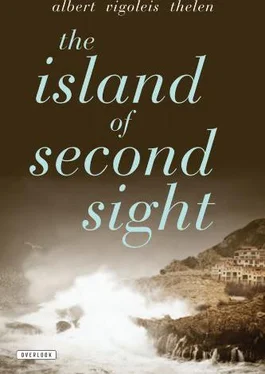A maid appeared, an island native in the familiar costume of the servant class: a kerchief of white tulle tied under the chin, called rebocillo , a long pigtail, and a little cap. Thus far, nothing out of the ordinary. Every halfway respectable family had a bunch of these servant maidens. The only thing unusual about this girl was her bosom, which was in constant motion and which moved me, too. I therefore made a bow that was too deep by a few vertebrae, still caught up in that transitional phase between the ludicrous German bowing of my student days and the natural casualness of Mediterranean greeting customs. I had not yet advanced to the universal shoulder-drumming, dust-producing embrace, which in any case would have been out of place with this girl. I simply presented her with my card, which contained a single word of identification: Vigoleis.
This domestic servant — and yes, that is what I wish to call her instead of “maid,” a term that all too quickly reminds me of the girl made famous in a poem by Christian Morgenstern, the “maid” who secretly had to nurse a baby “with a head made of cheese,” a mental association that could prove deleterious to my admittedly dubious intentions upon entering this house. Besides, I had no particular need for this associative borrowing from Herr Morgenstern, the creator of the Gallows Songs . Using his own inner rhyming dictionary, Vigoleis was perfectly capable of filling psychoanalytical gaps of this sort. And as far as this particular girl was concerned, he was determined to set a personal example, no matter if she was a “chaste, self-styled kitchen maid, / neither clean nor bright, / brazenly deceiving her employers / in plain sight” and was not nourishing a cheesy brat at her bosom. If I were writing as a Romantic, having come into the world a century earlier, it would be almost automatic for me to spice up these jottings with rhymes in the manner of Eichendorff’s Ne’er-Do-Well , who every few pages breaks out in song. Such exuberance has been out of fashion, indeed it has been considered shameful, ever since people no longer hike their way through the wide, wide world but instead take elevators and are constantly fleeing from potentates. Poems have in fact become literary contraband. Our publishers are anxiously on guard against verse getting smuggled into prose, which is what they make their money from. In the realm of rhyme, as in so many other ways, the Romantics were closer to reaching the Blue Flower than we starless descendants in our century of literary sham.
The domestic servant read the single word on my card. Why, she could actually read! She looked at me, then again at my card, smiled, and asked me something that confused me even more than her bosomy appeal: Was I a Vigoleis? Indeed I was, and decidedly so, I said after a moment’s pause during which I pondered myself as if suddenly casting a bolt of light on my own person. But then I realized that her question meant something rather different. A “Vigoleis”—she interpreted the word as a title, a designation of profession, an indication of social rank on the order of “Voyvod,” “Padishah,” or “Mahonda,” someone before whom one must sink to one’s knees if one weren’t such a pretty girl with flirty eyes and a long pigtail that stuck out stiffly in back and that had at its very end an even stiffer piece of string that signified her boss’ dignified rank. “You wish…?”
I handed her the letter, explaining that this was why I had come. She asked me to follow her. We entered a room that contained, besides a cuspidor, a single mouse. The latter skittered away, leaving me alone with the ceramic pot, while the domestic servant disappeared behind another door. She soon re-entered and, still smiling, beckoned me into an adjoining space, the waiting room. The servant girl retired. I made another deep bow.
Now I was free to examine the testimonials and letters of gratitude that were displayed on the walls. The sequence of documents had been arranged with the skill of a museum curator who knows just how to force a visitor to wander along the exhibit, taking everything in and educating himself in the process — art for art’s sake. The arrangement forced me in addition to pursue a train of thought concerning the psychology of the waiting room — a subject that cries out for scholarly investigation. Generally speaking, the installations range from that of a pre-torture chamber to a Shrine to the Blessed Mother of Merciful Succor, and on to the boudoir of a wealthy bordello madam. Don Fulgencio apparently aimed for a synthesis of all such types. I didn’t mind waiting.
The texts of these testimonials were instructive. Two of them, in particular, caught my attention. The first was written in the hand of His Royal Highness the King — a clear refutation of Robespierre’s claim that kings were illiterate. The letter was a request to Don Fulgencio that he provide a child free of hemophilia. The man who wrote this was already living in exile, perhaps now liberated from any worry about the mysterious corpuscles whose lack of coagulatory capability may have had no influence at all on the fall of the monarchy, as was bruited about among utopian monarchists during the early years of the Republic. The second document informed the reader that an order of nuns in Alicanta was willing to entrust all the orphans in its care to the good offices of Don Fulgencio.
As in an art gallery, I made the rounds of this exhibit, but without a printed catalogue and unhindered by a pressing crowd of visitors incapable of adapting to the tempo dictated by the works of art — or, to put it more accurately, the tempo that the art works would require if today the picture-postcard aspect of art had not become predominant. To appease this trend, all curators have installed postcard stands at the gallery exits. Don Fulgencio had a different idea. Scarcely had I studied the final line of text when she again appeared, my bosom friend from 1001 Nights , to guide me through a dark corridor and into a spacious room. An elderly gentleman stepped toward me.
This was the master of the house. There was no need for the domestic servant to whisper it to me: this was the legendary Don Fulgencio.
And what a Fulgencio he was! Such masculine effulgence! I estimated the age of this phenomenon, this flesh-and-blood personage out of the mythological mists, at about 80 years, although I must admit that I am seldom correct with guesses of this sort. If my own exact age down to the minute were not so fully documented by oral tradition and, even more reliably, by the official stamps so prevalent in our time, I would never come near to surmising it, whereas the age of my Vigoleis, whom I myself baptized, is beyond any calculation. When it comes to women, this matter can become acutely embarrassing. Not, of course, with women like Mamú, who at any age can contradict their own birth certificates, women who at 50 have no need for facial alteration or whose mouths at 80 still display their eternal youthful smile. No, the women I have in mind are those tragic, ghostly ones who, with valises full of cosmetic nostrums, approach the borderline where birthdays are no longer celebrated and where the tortoise veers between the purely vegetative and the purely animalic state. Once arrived at the 50-year checkpoint, they apply makeup in order to pass for thirty-something, with the result that they look like ladies in their seventies on Ash Wednesday.
Much too little attention has been paid to this subject. It has given rise to murder and manslaughter; marriages have broken apart long before their time; the masculine world has been forced to stand witness as an entire generation has been passed over, just as certain kids skip a whole year in school. Ladies who, fretting over their crow’s feet, rush out to buy salves and ointments, will never reach their goal. Indian fakirs go about this with herbs manipulated beneath magical textiles; they, too, achieve amazing sudden shifts in age. I dare say that the renowned forger Van Meegeren, if he had ever set his sights on the cosmetic mystification of women’s faces in a beauty salon in Paris or Amsterdam, could have become a very rich man. It would have occurred to him to adorn the abandoned mistress of some Monte Carlo billionaire with a masterful Mona Lisa smile, so that whatever remained of her gilded undercoating would be revealed only within the confines of a chambre séparée . Instead, by deploying his divinely inspired artistic fakery, this man succeeded in confounding the academic expertise of art connoisseurs the world over, in the process nailing them — and himself — to the cross. And there they now hang, as tokens of ignorance and fanatical ambition. Meanwhile, stock in the fine arts keeps rising in value, in reverse proportion to the decline of artistic discrimination. For the genuine comprehension of art, it is necessary to approach it from inside, with the heart, and not with the aid of litmus paper and X-rays. Specialists in the epidermis of art who stumbled over The Apostles at Emmaus are the very same ones who now have discovered primitive man’s l’art pour l’art in the caves of Altamira, Valltorta, Covalanes, and elsewhere. They have yet to arrive at the caves of Mallorca, although there, too, the Van Meegerens of the Ice Age did their work… But enough on this subject for now. At the moment I am eye-to-eye with Don Fulgencio, and my digressions could make him disappear in a fog.
Читать дальше












